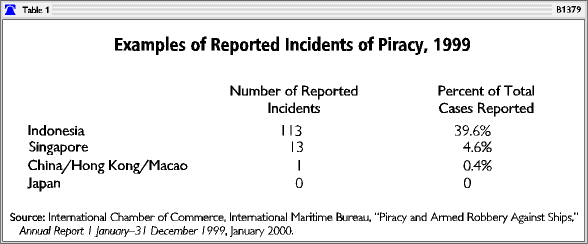Maritime piracy is back on the foreign policy radar screen. Reported attacks against commercial ships have tripled over the past decade, increasing last year alone by 40 percent.1Nearly two-thirds of thew attacks in 1999 occurred in Asia, with 113 of the 285 reported cases taking place in Indonesia's waters and ports. The risk of attack is increasing with 90 percent of the world's trade moving via ship and 45 percent of all shipping moving through the pirate-infested waters of Asia. Clearly, piracy is becoming an increasing threat to global trade.
The United States is the world's largest trading nation, and although the dollar amount of losses due to piracy is difficult to assess, America's reliance on trade makes any attack on ships in foreign waters or ports, especially those of its trading partners, a maritime concern. Both the U.S. Department of State and the U.S. Coast Guard consider maritime piracy a problem that merits U.S. participation in regional seminars on the issue. Although today's pirates target their victims in ways that may limit a direct U.S. response, several steps can be taken to help protect maritime trade and to assist other nations in improving their ability to combat piracy and reduce the threat.
Modern Maritime Piracy
Piracy has been a nagging problem in the Southeast Asian archipelago for centuries.2The recent steep rise in piracy in the region, however, is a result of the Asian financial crisis that began in Thailand in late 1997 and the political instability in Indonesia, which led to the underemployment and unemployment of thousands of people.
Today, acts of maritime piracy range from the classic boarding and hijacking of a merchant vessel on the high seas to the more common act of stealing from the ship while it is anchored. In fact, 72 percent of all attacks on merchant vessels are committed while the ship is berthed or anchored in port, and most of the attacks on vessels at sea occur in a country's territorial waters. The targets of an attack are usually the contents of the ship's stores and safe and the valuables of its crew. Stealing a ship or its primary cargo on the high seas represents only a small portion of the reported crimes.
Nevertheless, almost all reported acts of piracy involve armed intruders who threaten and often injure, kidnap, or kill members of the crew. Today's pirates appear to be a heterogeneous group that includes opportunistic fishermen, common criminals, Asian mafia, and in some cases members of the maritime security forces responsible for safeguarding shipping. The fact that most attacks occur while a ship is in port or anchored in adjacent territorial waters raises the likelihood that some of the maritime security forces in this region could be complicit in these crimes.
Many reports describe heavily armed men with military-style weapons. For example, on March 17, 1999, 20 pirates boarded the cargo ship Marine Master off the west coast of Thailand. The pirates wore army uniforms and masks, and carried automatic weapons. The 16 members of the crew were kidnapped and then set adrift in tiny inflatable rafts on March 21. Fortunately, fishermen rescued the crew, and the ship was eventually recovered in a Chinese port.3
The three components of maritime industry most affected by piracy are the shippers (manufacturers that own the cargo), carriers (companies that own the vessels), and insurers of the ships and cargoes. In the highly competitive shipping market, the carriers often decide not to report incidents of piracy. They appear to prefer to cover the losses out of their own resources rather than pay increased insurance costs after placing a claim or incurring delays due to an official investigation that can result in additional port costs of up to $10,000 a day. With many pirate attacks going unreported, calculating the amount of financial damage caused by this maritime crime is very difficult; estimates range as high as $16 billion annually.4
Beyond the physical danger to seamen and the loss of property, the rising costs associated with piracy and imposed on shippers, carriers, and insurers threaten America's diplomatic efforts in Asia. To recoup their losses from piracy, insurers raise rates for carriers that cross the more dangerous waters; some carriers feel compelled to employ armed guards. Both activities raise the cost of shipping.
As the United States lobbies to reduce trade barriers in Asia, these increased costs from piracy serve as a non-tariff barrier to trade. In addition, the added insurance costs and safety risks for trading in particularly dangerous ports act as an indirect economic boycott, restraining companies from conducting business with many of America's friends or allies that are least able to afford direct efforts to combat the piracy.
Piracy in the Asia-Pacific Region
Significantly, incidents of piracy are far fewer in ports and waters of Asian countries that have fully trained and reasonably well-paid maritime security forces and where the rule of law is respected--countries such as Japan, Korea, Taiwan, and Singapore (see Table 1). The countries with the most significant problems with piracy are Indonesia, Thailand, the Philippines, Malaysia, and Burma.

Most of the personnel employed in Southeast Asia's maritime security forces are grossly underpaid. As a share of gross domestic product (GDP), for example, Indonesia's defense budget is the lowest in Southeast Asia. Furthermore, as a result of the Asian financial crisis, the value of its defense budget declined by 65 percent from 1997 to 1998, aggravating the already tight fiscal problems that prevent it from allocating more to its maritime security force.
Moreover, in many of Southeast Asia's armed forces, a culture of corruption has evolved under years of authoritarian governments, often abetted by the military. With limited budgets, the military often cannot afford to provide sufficient pay to officers and lower ranking members, who then resort to "off budget" sources of income. In countries with high tariff barriers, such as many Asian countries, smuggling is a lucrative business and works well for fencing pirated goods.
The problems of underpaid maritime security forces and smuggling infect China's People's Liberation Army (PLA) Navy as well. Recent reports describe documented attacks on a number of ships on the high seas that were boarded by personnel from military gunboats bearing the markings of the PLA Navy. The pirates reportedly were dressed in PLA Navy uniforms. These reports illustrate that although piracy is not condoned in the regional maritime security forces, the temptation to participate in it or to turn a blind eye to it in exchange for kickbacks or bribes appears to be very strong.
Washington's Efforts to Combat Piracy
The Clinton Administration's activities to battle the problem of piracy have been appropriately measured, but they are still insufficient to address the problems of piracy in the ports. For example, the U.S. Department of State and the U.S. Coast Guard have participated in regional seminars and workshops on piracy and armed robbery and have contributed to the writing of circulars for the United Nations' International Maritime Organization (IMO).5
The IMO circulars recommend particular actions that participant governments, national agencies, and the shipping industry can take to reduce a ship's vulnerability to attack. For example, one circular, noting that ships are forced to carry large sums of cash in the ship's safe because of exchange restrictions in some countries, recommends that those states use a more flexible approach.6 Another circular recommends that ship masters adopt ship security plans and offers suggestions on the elements of such a plan and how to implement it.7
These activities have been widely applauded by the shipping and carrier industry. To date, however, there has been no attempt by either the United States or the IMO to promulgate security guidelines for the ports themselves. Although more than 70 percent of piracy takes place in ports, no internationally sanctioned security guidelines (similar, for example, to guidelines distributed by the aviation industry) are distributed to port authorities.
| Some Reported Cases of Maritime Piracy and Armed Robbery The International Maritime Bureau (IMB) of the Paris-based International Chamber of Commerce tracks the growing number of pirate attacks through its Piracy Reporting Centre. "Weekly Piracy Reports" are posted on the IMB?s Web site. The June 16, 2000, report, for example, mentions the following cases:
The June 6?12, 2000, "Weekly Piracy Report" urges all ships to use "extra caution" in "all ports in Indonesia, Gelasa Strait, Bangka Strait, Berhala Strait, Sunda Strait, Bangkok Bar, Manila Bay, Singapore Strait, Phillip Channel, Sprately Island, Chittagong Roads, Mongla Anchorage, Chennai anchorage, Tuticorin Roads, Kandla, Gulf of Aden, the Somali coast and Nigerian ports. All vessels are advised to maintain anti-piracy watches and report all suspicious movements of craft." Source: ICC Commercial Crime Services at www.iccwbo.org/ccs/imb_piracy/weekly_piracy_report.asp. |
In order to convince the maritime industry that Asian ports and waters are safe--which would have a beneficial effect by reducing insurance fees and shipping costs--the Administration and Congress should take several low-profile and low-cost steps to help America's trading partners and allies combat piracy. For example:
-
The State Department should recommend that governments in regions most affected by piracy widely report all steps taken to combat piracy, both to make it clear that criminals will be apprehended and to dispel any notion of complicity.
In addition, the governments of the coastal states should demonstrate that the steps they have implemented result in a decrease in attacks against shipping vessels in their waters. Without such evidence, the cost of shipping to their countries will continue to increase, thereby restricting commerce, and the perceived competence and legitimacy of the maritime security forces of the region's governments will continue to decline. -
The Administration should encourage the International Maritime Organization to take responsibility for recommending specific port security measures.
Based on recommendations and circulars distributed by the IMO, carriers and shippers are familiar with precautions that can be taken to prevent forced boarding by pirates, including the use of armed guards. But as long as ports have not implemented fundamental and internationally sanctioned security measures, they will continue to be easy targets for pirates. -
The Administration should encourage substantive reform of maritime security forces, particularly in Southeast Asia.
Because it is highly likely that these forces are complicit in a significant portion of the piracy taking place today, Washington should avoid providing them with direct assistance before they have implemented concrete measures to prevent corruption. Appropriate actions by the governments should include sufficient funding of their maritime security forces to afford their personnel and police adequate and competitive salaries and decrease the incentive to participate in piracy. -
Congress should authorize funds for the U.S. Coast Guard to train foreign maritime organizations to fight piracy.
Each country in Southeast Asia uses different organizations to battle piracy--such as the navy, coast guard, naval police, port police, or customs bureaus. By virtue of its authority, structure, experience, and competence, the U.S. Coast Guard is best suited to assist the various maritime security forces in determining and implementing appropriate measures to combat piracy.
Conclusion
Heightened U.S. participation in the battle against piracy would show support and encouragement for the U.S. and international maritime industry and at the same time would discourage acts of piracy. Substantive reductions in the number of pirate attacks, however, will require the governments of Southeast Asia in particular to implement strong anti-piracy measures.
To enhance trade with America, the Administration must convince the governments in regions most affected by piracy to demonstrate, clearly and purposefully, their determination to stem the incidence of maritime piracy, to crack down on corrupt maritime forces, and to secure their ports and waters from the threat of piracy.
Dana R. Dillon is Policy Analyst for Southeast Asia in the Asian Studies Center at The Heritage Foundation.

